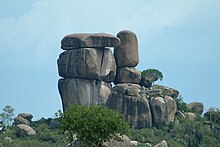Tor (rock formation)

A tor, which is also known by
Etymology
Although English topographical names often have a Celtic etymology, the Oxford English Dictionary lists no cognates to the Old English word in either the Breton or Cornish languages (the Scottish Gaelic tòrr is thought to derive from the Old English word). It is therefore accepted that the English word Tor derives from the Old Welsh word tẁrr or twr,[2] meaning a cluster or heap.[3]
Formation

Tors are landforms created by the
For example, the
Where joints happen to be unusually widely spaced, core blocks can survive and remain above the weathering surface, developing into tors. These can be monolithic, as at Haytor and Blackingstone Rock, but are more usually subdivided into stacks, often arranged in avenues. Each stack may include several tiers or pillows, which may become separated: rocking pillows are called logan stones. These stacks are vulnerable to frost action and often collapse leaving trails of blocks down the slopes called clitter or clatter. Weathering has also given rise to circular "rock basins" formed by the accumulation of water and repeated freezing and thawing. An example is found at Kes Tor on Dartmoor.
Dating of 28
See also
- Bornhardt – A large dome-shaped, steep-sided, bald rock
- Etchplain – Plain where the bedrock has been subject to considerable subsurface weathering
- Inselberg – Isolated, steep rock hill on relatively flat terrain
- Nubbin (landform) – Small hill of bedrock with rounded residual blocks
- List of geographical tors
References
- ^ a b Ehlen, J. (2004) Tor in Goudie, A., ed., pp. 1054-1056. Encyclopedia of Geomorphology. Routledge. London, England.
- ISBN 978-0-415-32738-1. Retrieved 21 June 2020.
- OED Online. Oxford University Press. Retrieved 10 December 2013. (subscription required)
- ^ Aguilera, Emilia Y.; Sato, Ana María; Llambías, Eduardo; Tickyj, Hugo (2014). "Erosion Surface and Granitic Morphology in the Sierra de Lihuel Calel, Province of La Pampa, Argentina". In Rabassa, Jorge; Ollier, Cliff (eds.). Gondwana Landscapes in southern South America. Springer. pp. 393–422.
- ^ "Tor | geology". Encyclopedia Britannica. Retrieved 12 June 2020.
- ISBN 978-0415364355
- ^ "Dartmoor Factsheet: Tor Formation" (PDF). Dartmoor National Park. 2002. Archived from the original (PDF) on 30 September 2011. Retrieved 21 December 2011.
- ^ Gunnell, Y., Jarman, D. and 8 others, 2013. "The granite tors of Dartmoor, Southwest England: rapid and recent emergence revealed by Late Pleistocene cosmogenic apparent exposure ages". Quaternary Science Reviews 612, 62–76
- ^ Adrian Hall, "New perspectives on a classic landscape of selective linear glacial erosion". The history of the Cairngorms: granite, landscape and processes. British Geological Survey
Further reading
- Mercer, Ian (2009). "The Physical Anatomy of Dartmoor". Dartmoor – A Statement of its Time. London: Collins. pp. 30–78. ISBN 978-0-00-718499-6.
